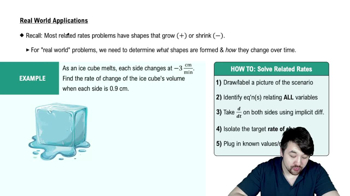Table of contents
- 0. Functions7h 52m
- Introduction to Functions16m
- Piecewise Functions10m
- Properties of Functions9m
- Common Functions1h 8m
- Transformations5m
- Combining Functions27m
- Exponent rules32m
- Exponential Functions28m
- Logarithmic Functions24m
- Properties of Logarithms34m
- Exponential & Logarithmic Equations35m
- Introduction to Trigonometric Functions38m
- Graphs of Trigonometric Functions44m
- Trigonometric Identities47m
- Inverse Trigonometric Functions48m
- 1. Limits and Continuity2h 2m
- 2. Intro to Derivatives1h 33m
- 3. Techniques of Differentiation3h 18m
- 4. Applications of Derivatives2h 38m
- 5. Graphical Applications of Derivatives6h 2m
- 6. Derivatives of Inverse, Exponential, & Logarithmic Functions2h 37m
- 7. Antiderivatives & Indefinite Integrals1h 26m
- 8. Definite Integrals4h 44m
- 9. Graphical Applications of Integrals2h 27m
- 10. Physics Applications of Integrals 2h 22m
4. Applications of Derivatives
Related Rates
Problem 3.11.7a
Textbook Question
The volume V of a sphere of radius r changes over time t.
a. Find an equation relating dV/dt to dr/dt.
 Verified step by step guidance
Verified step by step guidance1
Start with the formula for the volume of a sphere: V = (4/3)πr^3.
Differentiate both sides of the equation with respect to time t to find the rate of change of volume with respect to time, dV/dt.
Apply the chain rule to differentiate the right side: dV/dt = d/dt[(4/3)πr^3] = (4/3)π * 3r^2 * (dr/dt).
Simplify the expression: dV/dt = 4πr^2 * (dr/dt).
This equation shows that the rate of change of the volume of the sphere with respect to time, dV/dt, is related to the rate of change of the radius with respect to time, dr/dt, by the factor 4πr^2.
 Verified video answer for a similar problem:
Verified video answer for a similar problem:This video solution was recommended by our tutors as helpful for the problem above
Video duration:
3mPlay a video:
Was this helpful?
Key Concepts
Here are the essential concepts you must grasp in order to answer the question correctly.
Related Rates
Related rates involve finding the rate at which one quantity changes in relation to another. In this context, we are interested in how the volume of a sphere changes with respect to time as the radius changes. By applying the chain rule, we can relate the rates of change of volume and radius.
Recommended video:

Intro To Related Rates
Volume of a Sphere
The volume V of a sphere is given by the formula V = (4/3)πr³, where r is the radius. This formula is essential for deriving the relationship between the volume and the radius. Understanding how volume depends on radius is crucial for applying calculus to find the rate of change of volume with respect to time.
Recommended video:

Example 5: Packaging Design
Chain Rule
The chain rule is a fundamental principle in calculus used to differentiate composite functions. In this problem, we apply the chain rule to express dV/dt in terms of dr/dt. This allows us to find how the volume's rate of change is influenced by the radius's rate of change, linking the two quantities effectively.
Recommended video:

Intro to the Chain Rule
Related Videos
Related Practice





